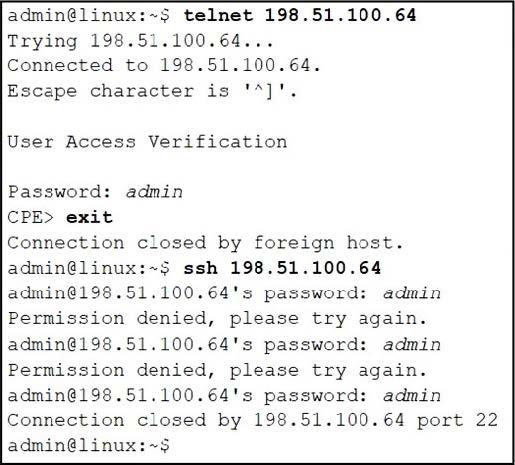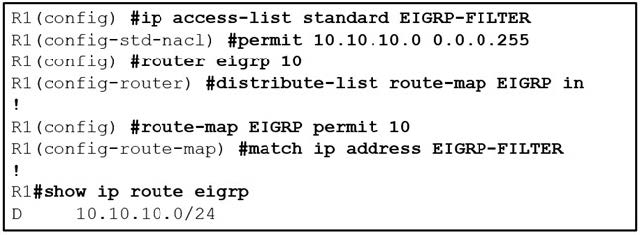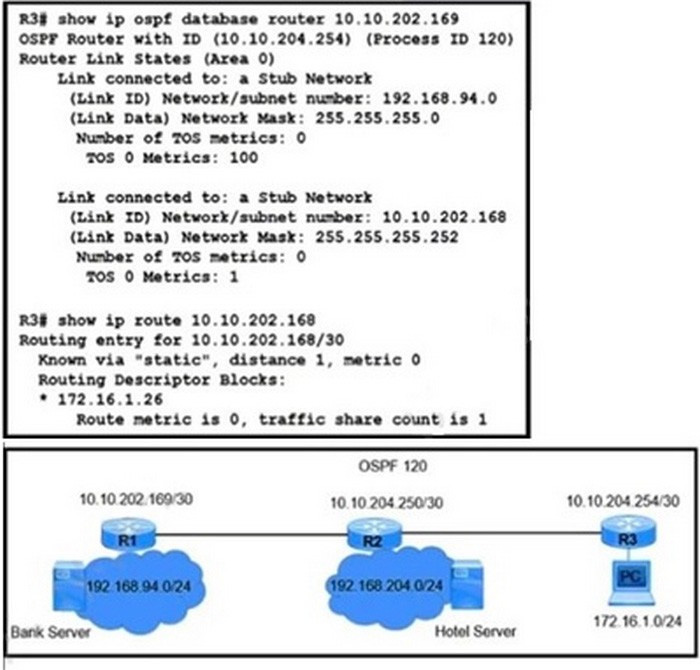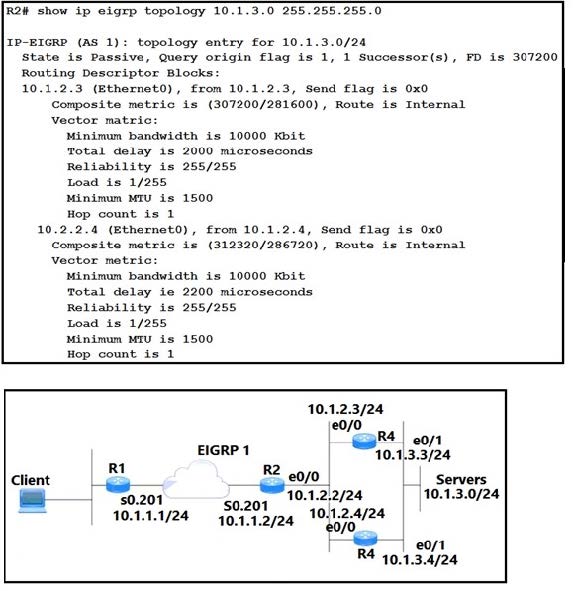Exam Details
Exam Code
:300-410Exam Name
:Implementing Cisco Enterprise Advanced Routing and Services (ENARSI)Certification
:CCNP EnterpriseVendor
:CiscoTotal Questions
:925 Q&AsLast Updated
:Apr 17, 2025
Cisco CCNP Enterprise 300-410 Questions & Answers
-
Question 361:
The network administrator must implement IPv6 in the network to allow only devices that not only have registered IP addresses but are also connecting from assigned locations. Which security feature must be implemented?
A. IPv6 Snooping
B. IPv6 Destination Guard
C. IPv6 Router Advertisement Guard
D. IPv6 Prefix Guard
-
Question 362:
Refer to the exhibit.

An administrator can log in to the device using Telnet but the attempts to log in to the same device using SSH with the same credentials fail. Which action resolves this issue?
A. Configure the VTY lines with login local.
B. Configure transport input all on the VTY lines to allow SSH.
C. Configure SSH service on the router.
D. Configure to use the Telnet user database for SSH as well.
-
Question 363:
Refer to the exhibit.

A CoPP policy is implemented to allow specific control traffic, but the traffic is not matching as expected and is getting unexpected behavior of control traffic. Which action resolves the issue?
A. Use match-any instruction in class-map.
B. Create a separate class map against each ACL.
C. Create a separate class map for ICMP traffic.
D. Use default-class to match ICMP traffic.
-
Question 364:
The network administrator is tasked to configure R1 to authenticate telnet connections based on Cisco ISE using RADIUS. ISE has been configured with an IP address of 192.168.1.5 and with a network device pointing towards R1
(192.168.1.1) with a shared secret password of Cisco123. If ISE is down, the administrator should be able to connect using the local database with a username and password combination of admin/cisco123.
The administrator has configured the following on R1:
aaa new-model ! username admin password cisco123 ! radius server ISE1 address ipv4 192.168.1.5 key Cisco123 ! aaa group server tacacs+ RAD-SERV server name ISE1 ! aaa authentication login RAD-LOCAL group RAD-SERV
ISE has gone down. The Network Administrator is not able to Telnet to R1 when ISE went down.
Which two configuration changes will fix the issue? (Choose two.)
A. aaa authentication login RAD-SERV group RAD-LOCAL local
B. aaa authentication login RAD-LOCAL group RAD-SERV local
C. line vty 0 4 login authentication RAD-LOCAL
D. line vty 0 4 login authentication default
E. line vty 0 4 login authentication RAD-SERV
-
Question 365:
Refer to the exhibit.

An engineer must filter incoming EIGRP updates to allow only a set of specific prefixes. The distribute list is tested, and it filters out all routes except network 10.10.10.0/24.
How should the engineer temporarily allow all prefixes to be learned by the router again without adjusting the existing access list?
A. A permit any statement should be added before completing the ACL with the required prefixes, and then the permit any statement can be removed.
B. A permit 20 statement should be added before completing the ACL with the required prefixes, and then the permit 20 statement can be removed.
C. A continue statement should be added within the permit 10 statement before completing the ACL with the required prefixes, and then the continue statement can be removed.
D. An extended access list must be used instead of a standard access list to accomplish the task.
-
Question 366:
Refer to the exhibit.

A network engineer finds that PC1 is accessing the hotel website to do the booking but fails to make payment. Which action resolves the issue?
A. Increase the AD to 200 of static route 192.168.94.0 on R3.
B. Configure a reverse route on R1 for PC1 172.16.1.0/24.
C. Decrease the AD to 5 of OSPF route 192.168.94.0 on R1.
D. Allow stub network 10.10.202.168/30 on router R3 OSPF.
-
Question 367:
An engineer creates a default static route on a router with a next hop of 10.1.1.1. On inspection, the engineer finds the router has two VRFs, Red and Blue. The next hop is valid for both VRFs and exists in each assigned VRF. Which configuration achieves connectivity?
A. ip route vrf Red 0.0.0.0 0.0.0.0 10.1.1.1 ip route vrf Blue 0.0.0.0 0.0.0.0 10.1.1.1
B. ip route vrf BLUE 0.0.0.0 255.255.255.255 10.1.1.1 ip route vrf RED 0.0.0.0 255.255.255.255 10.1.1.1
C. ip route vrf Red 0.0.0.0 255.255.255.255 10.1.1.1
D. ip route vrf Blue 0.0.0.0 255.255
-
Question 368:
Refer to the exhibit.

A network administrator configured name resolution for IPv6 traffic to be allowed through an inbound access list. After the access list is applied to resolve the issue, name resolution still did not work. Which action does the network administrator take to resolve the name resolution problem?
A. Add permit udp any eq domain 53 any log in the access list
B. Remove ipv6 inspect ipv6-firewall in from interface gi0/1
C. Add permit udp any eq domain any log in the access list
D. Inspect ipv6 inspect name ipv6-firewall udp 53 in global config
-
Question 369:
Refer to the exhibit.

An engineer notices a connectivity problem between routers R1 and R2. The frequency of this problem is high during peak business hours. Which action resolves the issue?
A. Increase the available bandwidth between R1 and R2.
B. Decrease the EIGRP keepalive and hold down timers on R1 and R2.
C. Increase the MTU on the interfaces that connect R1 and R2.
D. Set static EIGRP neighborship between R1 and R2.
-
Question 370:
Refer to the exhibit. A network is configured for EIGRP equal-cost load balancing, but the traffic destined to the servers is not load balanced. Link metrics from router R2 to R3 and R4 are the same. Which delay value must be configured to resolve the issue?

A. 2200 on R4 E0/1
B. 200 on R3 E0/1
C. 120 on R3 E0/1
D. 120 on R4 E0/1
Related Exams:
300-410
Implementing Cisco Enterprise Advanced Routing and Services (ENARSI)300-415
Implementing Cisco SD-WAN Solutions (ENSDWI)300-420
Designing Cisco Enterprise Networks (ENSLD)300-425
Designing Cisco Enterprise Wireless Networks (ENWLSD)300-430
Implementing Cisco Enterprise Wireless Networks (ENWLSI)300-435
Automating and Programming Cisco Enterprise Solutions (ENAUTO)300-440
Designing and Implementing Cloud Connectivity (ENCC)350-401
Implementing and Operating Cisco Enterprise Network Core Technologies (ENCOR)
Tips on How to Prepare for the Exams
Nowadays, the certification exams become more and more important and required by more and more enterprises when applying for a job. But how to prepare for the exam effectively? How to prepare for the exam in a short time with less efforts? How to get a ideal result and how to find the most reliable resources? Here on Vcedump.com, you will find all the answers. Vcedump.com provide not only Cisco exam questions, answers and explanations but also complete assistance on your exam preparation and certification application. If you are confused on your 300-410 exam preparations and Cisco certification application, do not hesitate to visit our Vcedump.com to find your solutions here.